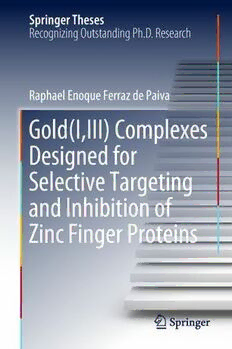
Gold(I,III) Complexes Designed for Selective Targeting and Inhibition of Zinc Finger Proteins PDF
Preview Gold(I,III) Complexes Designed for Selective Targeting and Inhibition of Zinc Finger Proteins
Springer Theses Recognizing Outstanding Ph.D. Research Raphael Enoque Ferraz de Paiva Gold(I,III) Complexes Designed for Selective Targeting and Inhibition of Zinc Finger Proteins Springer Theses Recognizing Outstanding Ph.D. Research Aims and Scope The series “Springer Theses” brings together a selection of the very best Ph.D. theses from around the world and across the physical sciences. Nominated and endorsed by two recognized specialists, each published volume has been selected foritsscientificexcellenceandthehighimpactofitscontentsforthepertinentfield of research. For greater accessibility to non-specialists, the published versions includeanextendedintroduction,aswellasaforewordbythestudent’ssupervisor explainingthespecialrelevanceoftheworkforthefield.Asawhole,theserieswill provide a valuable resource both for newcomers to the research fields described, and for other scientists seeking detailed background information on special questions. Finally, it provides an accredited documentation of the valuable contributions made by today’s younger generation of scientists. Theses are accepted into the series by invited nomination only and must fulfill all of the following criteria (cid:129) They must be written in good English. (cid:129) ThetopicshouldfallwithintheconfinesofChemistry,Physics,EarthSciences, Engineeringandrelatedinterdisciplinary fields such asMaterials,Nanoscience, Chemical Engineering, Complex Systems and Biophysics. (cid:129) The work reported in the thesis must represent a significant scientific advance. (cid:129) Ifthethesisincludespreviouslypublishedmaterial,permissiontoreproducethis must be gained from the respective copyright holder. (cid:129) They must have been examined and passed during the 12 months prior to nomination. (cid:129) Each thesis should include a foreword by the supervisor outlining the signifi- cance of its content. (cid:129) The theses should have a clearly defined structure including an introduction accessible to scientists not expert in that particular field. More information about this series at http://www.springer.com/series/8790 Raphael Enoque Ferraz de Paiva Gold(I,III) Complexes Designed for Selective Targeting and Inhibition of Zinc Finger Proteins Doctoral Thesis accepted by the University of Campinas, Campinas, Brazil 123 Author Supervisor Dr. Raphael EnoqueFerraz dePaiva Prof. PedroPauloCorbi Institute of Chemistry Institute of Chemistry University of Campinas University of Campinas Campinas, Brazil Campinas, Brazil ISSN 2190-5053 ISSN 2190-5061 (electronic) SpringerTheses ISBN978-3-030-00852-9 ISBN978-3-030-00853-6 (eBook) https://doi.org/10.1007/978-3-030-00853-6 LibraryofCongressControlNumber:2018955155 ©SpringerNatureSwitzerlandAG2018 Thisworkissubjecttocopyright.AllrightsarereservedbythePublisher,whetherthewholeorpart of the material is concerned, specifically the rights of translation, reprinting, reuse of illustrations, recitation, broadcasting, reproduction on microfilms or in any other physical way, and transmission orinformationstorageandretrieval,electronicadaptation,computersoftware,orbysimilarordissimilar methodologynowknownorhereafterdeveloped. The use of general descriptive names, registered names, trademarks, service marks, etc. in this publicationdoesnotimply,evenintheabsenceofaspecificstatement,thatsuchnamesareexemptfrom therelevantprotectivelawsandregulationsandthereforefreeforgeneraluse. The publisher, the authors and the editors are safe to assume that the advice and information in this book are believed to be true and accurate at the date of publication. Neither the publisher nor the authorsortheeditorsgiveawarranty,expressorimplied,withrespecttothematerialcontainedhereinor for any errors or omissions that may have been made. The publisher remains neutral with regard to jurisdictionalclaimsinpublishedmapsandinstitutionalaffiliations. ThisSpringerimprintispublishedbytheregisteredcompanySpringerNatureSwitzerlandAG Theregisteredcompanyaddressis:Gewerbestrasse11,6330Cham,Switzerland The most exciting phrase to hear in science, the one that heralds the most discoveries, is not “Eureka!” (I found it!) but “That’s funny…” —Isaac Asimov The mediocre teacher tells. The good teacher explains. The superior teacher demonstrates. The great teacher inspires —William Arthur Ward I dedicate this thesis to every teacher (in the most fundamental sense of the word) I had during my life. Luckily, I’ve had many great teachers. ’ Supervisor s Foreword Raphaeljoinedmygroup asanundergraduatestudentattheInstituteofChemistry of the Campinas State University (UNICAMP), Brazil, in 2010. He obtained his master’s degree working in the synthesis and biological evaluation of silver and platinum complexes with anti-inflammatory agents. Raphael developed his Ph.D. project focusing on the development of gold(I,III) compounds for the inhibition of zinc finger proteins. This project was developed at UNICAMP with a one year exchange at VCU under the supervision of Prof. Nicholas Farrell. The zinc finger family of proteins was explored as target in this work, in par- ticular, the nucleocapsid protein (NCp7) from the human immunodeficiency virus (HIV-1).OneofthemostremarkablestructuralandfunctionalcharacteristicsNCp7 is the presence of two -Cys-X2-Cys-X4-His-X4-Cys- zinc finger (ZnF) domains. Inhibitionofthisproteinsleadstothelossofviralinfectivity,suggestingthatNCp7 inhibitors could be developed as alternatives to the typical anti-retroviral therapies available today. The broad contribution of this thesis was on the development of gold-based com- pounds for the inhibition of zinc finger proteins. Gold(I) compounds were developed using phosphine ligands as “carriers” and labile pyridine derivatives or chloride as co-ligands. Innovative approaches were used for evaluating the interaction of gold(I) compounds with zinc fingers. Travelling-wave ion mobility mass spectrometry (TWIM-MS)coupledwithtandemMSprovedtobeanextremelypowerfultechnique fordetectingmetallationsitesinzinc fingers,aswellasforidentifyingandseparating conformers.X-rayabsorptionspectroscopy(XAS)wasusedforidentifyingchangesin the coordination sphere and geometry of gold. In addition, gold(III) compounds were alsodeveloped.Stabilizinggold(III)representsaninterestingchallenge,asitisproneto reduction in the biological media. The organometallic compounds [Au(2-benzylpy- ridine)Cl ] isparticularlynoteworthy.It wasabletoinhibitNCp7throughasuigeneris 2 mechanism based on a gold-catalyzed C-S bond formation. ix x Supervisor’sForeword Finally,thededicationandmotivationofDr.RaphaeldePaivaarenoteworthy.He was always willing to help his colleagues and ready for new challenges. His published works and conferences awards confirm his wonderful work and his dedicationtoscience.ItwasagreathonortometowriteaboutDr.RaphaelEnoque Ferraz de Paiva and I wish him success in his career. Campinas, Brazil Prof. Pedro Paulo Corbi July 2018 Abstract ManycomplementaryapproacheshavebeenusedtoinactivatetheHIV-1nucleocapsid protein(NCp7)zincfingerfortherapeuticuse.ThecysteineresiduesofNCp7aresome of the most nucleophilic of all zinc-bound thiolates found in proteins. Although it is considered anoblemetal,goldhasaveryrichchemistry undertherightconditions.Itis capableofformingcoordinationcompoundsinbothofitstypicaloxidationstates(1+ and3+).Gold(I)formslinearcompounds,withcoordinationnumber2,whilegold(III) formssquareplanarcompounds withcoordinationnumber 4.Electron-richmetalssuch asgoldareparticularlysuitablefordesigningmetal-basedzincejectorsbecause,assoft Lewis acid electrophiles, they have high affinity for Cys residues. Without the proper tridimensionalfolding granted by Zn coordination, NCp7 is inactivated and unable to furtherrecognizespecificnucleicacidsequences. AseriesofAu(I)complexeswiththegeneralstructure[Au(L)(PR )](R=EtorCy) 3 wasdesigned.ThetwoaromaticresiduesinthestructureofNCp7(Phe16andTrp37) areresponsibleforp-stackingwithpurineandpyrimidinebasesfoundonRNAand DNA.Thepresenceoftheseresiduescanbeusedforintroducinganextraselectivity componentinthedesignedcompounds,asanaromaticLligandcanbeused.Wealso examinedforcomparisonthe“standard”gold-phosphinecompoundauranofinwhich containsathiosugarligandcoordinatedto{Au(Et P)}.Thenatureofthephosphine 3 andthenatureofLaffectboththereactivitywiththeC-terminalNCp7ZnF2andthe “full”NCp7aswellasthefinalcoordinationsphereofAuonceincorporatedintothe protein.Inthisreaction,thefirststepistheelectrophilicattackoftheAu(I)-phosphine compounds on the Zn-coordinated residues, forming a heterobimetallic {R PAu}- 3 ZnF species. Two alternative pathways open up from here on. In the most typical pathway,afterZndisplacement,the{R PAu}moietycanremaincoordinatedtoaCys 3 residue. Afterwards, the phosphine is lost and a Cys-Au-Cys gold finger (AuF) is obtained.Inthismechanism,compoundswithslowerreactivitysuchas[Au(dmap) (Et P)]allowustoprobetheinitial auration steps,withspeciessuchas{Et PAu}- 3 3 apoNCp7stillbeingpresent.Longerincubationtimesormorereactivecompounds suchasthechlorideprecursorsprovideinformationonthefinalspecies,thegoldfinger itself. In an alternative pathway, observed for the model compound auranofin, the {R PAu}moietycoordinatestoaHisresidue,andthefinalhypotheticalAuFobtained 3 xi
